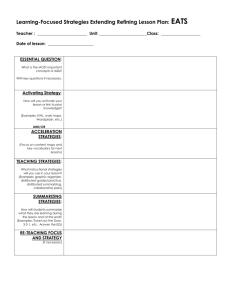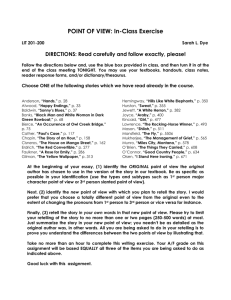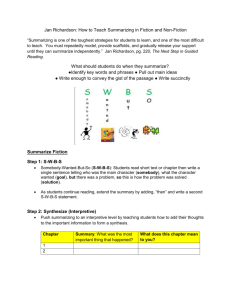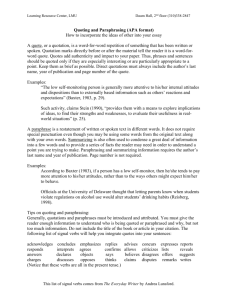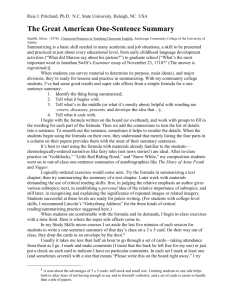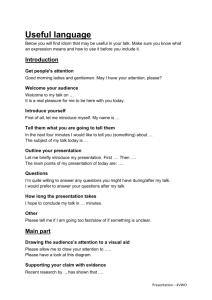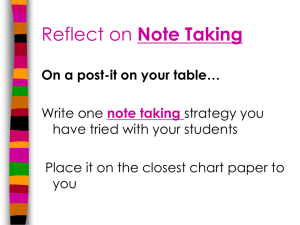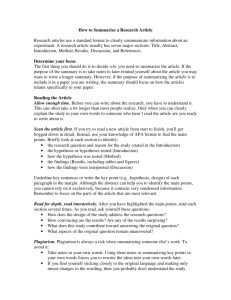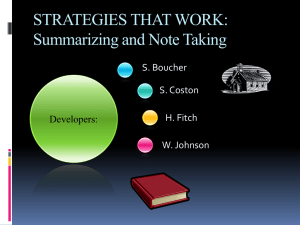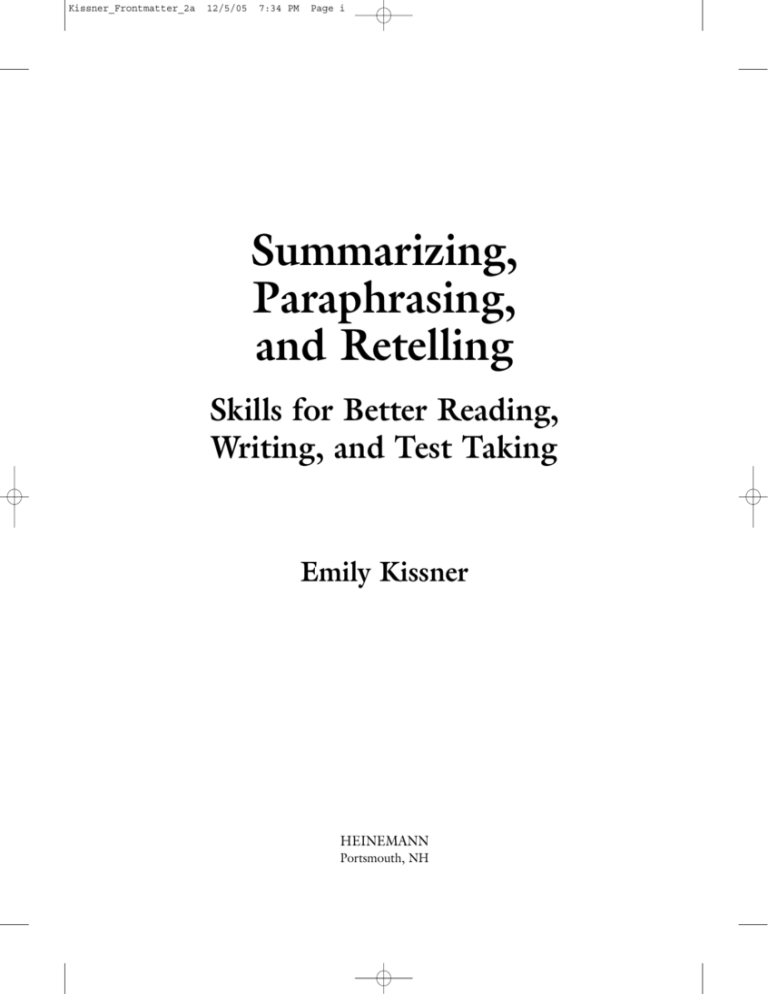
Kissner_Frontmatter_2a
12/5/05
7:34 PM
Page i
Summarizing,
Paraphrasing,
and Retelling
Skills for Better Reading,
Writing, and Test Taking
Emily Kissner
HEINEMANN
Portsmouth, NH
Kissner_Frontmatter_2a
12/5/05
7:34 PM
Page ii
Heinemann
A division of Reed Elsevier Inc.
361 Hanover Street
Portsmouth, NH 03801–3912
www.heinemann.com
Offices and agents throughout the world
© 2006 by Emily Kissner
All rights reserved. No part of this book may be reproduced in any form
or by any electronic or mechanical means, including information storage
and retrieval systems, without permission in writing from the publisher,
except by a reviewer, who may quote brief passages in a review, with the
exception of Figures 3–1, 4–1, 4–2, 4–4, 4–5, 5–1 to 5–3, 6–1, 6–4,
6–5, 7–1, 8–1, 8–2, 9–1, 9–4, 11–1 to 11–4, 13–1, and 13–2, which
may be copied for classroom use only.
Library of Congress Cataloging-in-Publication Data
Kissner, Emily.
Summarizing, paraphrasing, and retelling : skills for better reading,
writing, and test taking / Emily Kissner.
p. cm.
Includes bibliographical references.
ISBN 0-325-00797-7 (alk. paper)
1. Reading comprehension. 2. English language—Composition
and exercises—Study and teaching. I. Title.
LB1050.45.K47 2006
372.47—dc22
2005028402
Editor: Danny Miller
Production service: Denise A. Botelho
Production coordinator: Sonja S. Chapman
Cover design: Jenny Jensen Greenleaf
Compositor: Gina Poirier
Manufacturing: Louise Richardson
Printed in the United States of America on acid-free paper
10 09 08
07
06
RRD
1
2
3
4
5
Kissner_Frontmatter_2a
12/5/05
7:34 PM
Page iii
Contents
LIST
OF
FORMS
v
ACKNOWLEDGMENTS
vii
INTRODUCTION
ix
1
Why Teach Summarizing?
1
2
Summarizing, Paraphrasing, and Retelling:
Related, But Not the Same
4
3
What Does a Good Summary Look Like?
10
4
Finding Out What Students Already Know
19
5
Topics and Main Ideas
33
6
Text Organization
49
7
Paraphrasing and Collapsing Lists
68
8
Summarizing Narrative Text
82
9
Using Story Elements to Improve Narrative Summaries
94
10
Talking to Learn: Retelling in the Intermediate Classroom
108
11
Scaffolding for Summarizing
116
12
Summarizing for the Content Areas
129
13
Summarizing for Assessment
134
CONCLUSION
143
REFERENCES
145
iii
Kissner_Frontmatter_2a
12/5/05
7:34 PM
Page v
List of Forms
3–1
Gardening with Native Plants
11
4–1
Native Plant Summaries
21
4–2
Summary Writing Knowledge Rating
23
4–4
Summary Checklist
25
4–5
The American Chestnut
27
5–1
Topic and Main Idea
39
5–2
Implicit Main Ideas Student Page
44
5–3
Make up a Main Idea
47
6–1
Text Features in Magazine Articles
52
6–4
Text Structures
63
6–5
Text Structure Picture Book Activity
64
7–1
The Karner Blue Butterfly
72
8–1
Summary Checklist
85
8–2
Sandbox Archaeologist
89
9–1
Story Map
97
9–4
Universal Themes
106
Steps for Summarizing Expository Text
Student Guide Sheet
122
11–2
Main Idea Group Preparation Sheet
125
11–3
Main Idea Group Leader Guidelines
126
11–4
Group Accountability Form
127
13–1
Wanted: The Five Most Invasive Plants
in the United States!
136
Peer Response
139
11–1
13–2
v
Kissner_Frontmatter_2a
12/5/05
7:34 PM
Page vii
Acknowledgments
To thank my husband, Stephen Kissner, for his help on this book is an
understatement. Without his encouragement, comments, and support,
this book would not exist and my classroom would be a very different
place. He is the most gifted teacher I know, and his fourth graders are
lucky indeed. When I came up with a new idea for teaching summarizing,
he was always willing to try it out in his classroom and provide me with
valuable feedback. This is as much his project as it is mine.
Dinnertime conversations with my family never stray far from teaching. My mother and father, Charles and Karen Pearce, are both teachers
as well. They have helped me in so many ways, from talking through difficult ideas to watching our two young sons while we worked on writing.
I would also like to thank my colleagues at Biglerville Elementary,
particularly Karen Daugherty, Tina McGough, and Megan McLean. Their
support has been invaluable as I made the transition from middle school
to elementary school. Rolland Kiracofe, who originally hired me to teach
at Northwest Middle School, set my teaching career in motion. I will
always be grateful for his kindness and encouragement.
Finally, I would like to thank all of the people that I worked with at
Heinemann. I wrote this book with a laptop balanced in one hand and a
baby held in the other, and I am so grateful for everyone’s help, support,
and kindness during a hectic time. I would especially like to thank editor
Danny Miller for his wonderful advice and comments.
vii
Kissner_Frontmatter_2a
12/5/05
7:34 PM
Page ix
Introduction
I started teaching language arts at the height of the whole language movement. The supervisor in my district had removed the old scope and
sequence, drill and kill–based curriculum in favor of a far more open curriculum that allowed teachers to plan their own lessons and make their
own judgments. “But I have no judgment!” I remember wailing to my
mother, also a teacher. “How do you think I learned what to do?” she
asked, and showed me her bookshelf, which was covered with stacks and
stacks of professional books. I got the message. I couldn’t expect to make
it through a career of teaching with only the knowledge I had picked up
in a handful of undergraduate courses. If I was going to be successful, I
needed to read. And read. And read.
During the next few years, I amassed my own collection of books.
When I came to a thorny patch in my instruction—for example, how to
get students to apply grammar skills to their writing—I would look
through the books for ideas and solutions. If I didn’t find the answer in
my own books, I would borrow from my mother’s bookshelf or the reading specialist’s. I knew that I couldn’t become comfortable with every
aspect of teaching reading and writing in one year, so I slowly built on my
knowledge base and developed my own judgment.
This helped me to cope with the changes that swept through my
classroom during the course of the next seven years. I started teaching
seventh grade writing, then added sixth grade writing to the mix. When
Integrated Language Arts came to our school a few years later, I was
thrilled to be able to teach a ninety-minute block of reading and writing.
Our state outcomes became content standards, our state testing program
was transformed from performance-based assessment to “selected
response,” or multiple choice, and the district middle school reading and
writing department was headed by three different supervisors who
ix
Kissner_Frontmatter_2a
x
Introduction
12/5/05
7:34 PM
Page x
dispersed three different curriculum manuals. As if these changes were
not enough, I uprooted myself after seven years and went to teach a
self-contained sixth grade class in a tiny rural district. Moving from a
district with 28,000 students to a district with 1,800 was quite a culture shock.
Some people may have found the pace frustrating, but I liked the
excitement. I learned how to adapt to new thinking and new ideas while
still holding on to the philosophies and structures that worked in my
classroom. The more things changed, the more I could see how some
things remained the same. Whether I was teaching to outcomes or standards, whether my curriculum was organized according to theme or
genre, whether I had a classroom with windows, I faced young adolescents every day. All the books in the world cannot prepare a teacher for
what happens once the students walk into the room.
I certainly wasn’t prepared to teach summarizing. Included as a content standard and an assessment anchor, I knew that summarizing was
important, and I dutifully tried to help my sixth and seventh graders write
summaries of both fiction and nonfiction texts. I envisioned smoothly
written short pieces, like those in TV Guide, that would elegantly capture
the essence of a text with a minimum of words.
What I got were stacks of bizarre constructions that claimed to be
summaries—or “sumeries,” as my students often wrote—that either
copied whole sentences of text, focused on just one section, or missed the
main points altogether. Sometimes I wondered if the students had read
the same text that I had. The more able students could occasionally pull
together a coherent comment or two, but often they would try to jam a
summary into the traditional paragraph template—topic sentence, supporting details, concluding sentence.
I learned many things from the article. How tomb robbers
took things from tombs, what they stole from tombs, and
what they were like. It was a great article.
I wasn’t sure of how to help them. My usual comments—
“Elaborate. Add more. Give more detail”—are not helpful for summarizing. The students thought I had become temporarily insane when I told
them, “That’s too long. Make it short. Are those details necessary?”
Standing in front of the classroom with a student summary on the
overhead projector, I struggled to explain to the students why it was not
effective.
Kissner_Frontmatter_2a
12/5/05
7:34 PM
Page xi
“But the article is about trees, right?” Patrick asked from the front
row. “So why can’t I say, ‘This article is about trees?’”
I floundered. As the teacher, I was supposed to know these things!
“It’s not good writing,” I said, finally.
“It sounds good to me,” Patrick said, to a chorus of agreement from
elsewhere in the room. “I think it’s fine.”
I tried to use various graphic organizers or catchy formulas, but I
couldn’t find anything that would work with every text every time. “Write
down the main points and important details,” I told the students, only to
realize that they could not find the main points or identify the important
details.
To make matters worse, the usual rubric we used to assess reading
comprehension questions did not work for summaries. We were focused
on getting kids to include text evidence in their responses to questions.
However, summaries don’t require explicit text evidence or references
back to the text, and when kids tried to add those elements, they created
some pretty strange responses.
This article was about tomb robbers in ancient Egypt. I know
this because the author made the title be “Tomb Robbers and
the Mummy’s Treasure.” The author explained what treasures
were in tombs and how the tomb robbers stole the treasures.
I know this because the author said so.
So I was faced with teaching something that I couldn’t explain and
couldn’t assess. It was time to hit the books and find out what was really
going on.
Strangely, though, I didn’t find very much written about summarizing. There were a few pages in a content area reading textbook, scattered
mentions in books about reading strategies, and philosophical ruminations about what is important in a text. Most discussions of summarizing
cited the same research and listed the same steps for helping kids to
improve their work. I found little to tell me why students don’t summarize well, what skills students need to write good summaries, or the relationship between summarizing and reading comprehension.
I knew that summarizing was important. Not only is it included on
content standards and tested on yearly assessments, but it is also a skill
used in everyday life. But the question remained—how would I teach it?
I expanded my search beyond the usual reference books and into
the realm of journal articles. Although there were many articles about
xi
Introduction
Kissner_Frontmatter_2a
xii
Introduction
12/5/05
7:34 PM
Page xii
summarizing through the mid and late 1980s, the topic dropped off the
scene through much of the past fifteen years, relegated to mentions in
articles aimed at high school and college teachers.
As teachers and students in my district focused on writing good
reading responses and finding text evidence to support their thinking,
there was little direct instruction in the skills required for summarizing.
This was and is a shame. The more I learned about summarizing, the
more I became convinced that it is a keystone skill for reading. Summarizing
deserves more than a brief mention in a language arts curriculum. The ability to summarize is at the heart of comprehension, the very essence of what
we want kids to be able to do. A few scattered activities and lists of steps
won’t help kids to grasp the power of skillful summarizing.
Using what I learned from the journal articles, I worked to break
down the skills required for summarizing. There are many! It requires the
purposeful synthesis of a number of discrete reading strategies and skills.
No wonder my students were having such problems. Many of my colleagues were facing the same problems that I was. “I try to skip through
summaries as quickly as I can,” another teacher confessed to me. “What
is the difference between a summary and a retelling?” someone else asked.
If we want to help our students to become engaged, strategic readers, we must include summarizing instruction in our reading and language
arts classrooms. As you will see, summarizing is a skill with far-reaching
implications for reading comprehension and content area success. The
time spent on teaching summarizing strategies will only help our students
to become more efficient, more effective learners.
Kissner_Ch01-02_2a
2
4
12/5/05
7:34 PM
Page 4
SUMMARIZING,
PARAPHRASING,
AND RETELLING
Related, But Not the Same
The scene was grim. Eight of us were packed into a cramped, unair-conditioned room, spending the first week of our summer in a kind of curricular sweatshop. Our task was daunting: to unite the previously divided
middle school reading and writing programs into one cohesive class. And
write 100 days of curriculum in one week, using enough detail so that
reading teachers could confidently teach the writing components and
writing teachers could teach the reading. The sixth grade table had rapidly devolved into a bizarre reading–writing turf war.
“I don’t think retelling is something we want to assess in middle
school,” a reading specialist said. “I mean, just being able to spit back the
characters and plot of a story doesn’t show any higher level thinking.” To
those of us who had taught writing, she said, patronizingly, “One of the
goals of teaching reading is to get kids to think critically.”
Really.
“Are you talking about retelling or summarizing?” asked a veteran
teacher.
“Aren’t they both the same thing?” someone else asked.
“If we include retelling—or summarizing—would it be a reading
activity or a writing activity?”
“How would we assess it?”
“Well,” said one teacher, who came from the more affluent part of
the district, “I don’t think summarizing is a skill that we should have to
teach in middle school. It’s time that we stop babying students and expect
them to use what they learned in elementary school.”
“Or should have learned,” someone else chimed in. Reading teachers and writing teachers united momentarily to agree that students should
have already learned basically everything before arriving in middle school.
Kissner_Ch01-02_2a
12/5/05
7:34 PM
Page 5
I’ve found that there’s no way to win one of these arguments. In this
case, nothing I could have said would have convinced any of these teachers that they were wrong. (Despite the fact that I was the only one who
had actually taught reading and writing together, I was still considered a
“writing” teacher, and therefore unable to comprehend reading issues!)
This group perpetuated four pervasive myths about the related skills of
summarizing, paraphrasing, and retelling.
Myth 1: Summarizing, Paraphrasing, and Retelling Are All the Same
Like many myths, this one has a grain of truth. Summarizing, paraphrasing, and retelling are closely related processes, and the ability to summarize depends on some level of skill with paraphrasing and retelling.
However, each of these processes is important in its own right as a
tool for comprehension and discussion. When students know the difference between these skills, they can choose the one they need for each circumstance.
Myth 2: Summarizing Is the Same as Recall
Many reading teachers have downplayed simple recall in recent years.
Being able to pick out one detail from a passage doesn’t show that a
reader has a well-developed understanding of the passage. However, summarizing requires students to comprehend, analyze, and synthesize ideas.
This is not just spitting back an answer! The reader processes text in one
form, makes judgments about the ideas, and restates the text in a new
form. This requires higher level thinking.
Myth 3: Students Should Already Know How to Do This
Summarizing, retelling, and paraphrasing are important skills for readers
of all levels, even those in college and beyond. Saying that students should
have “learned” these skills in a previous class or grade is like saying that
students should have learned how to write in first grade and therefore
need no more instruction in the topic. The logic just doesn’t work.
A third grade teacher may do an excellent job of working with students to summarize third grade text; but, in eighth grade, text is much
more complex. Students who mastered summarizing in third grade may
need explicit instruction in meeting the new demands of eighth grade–
level text.
5
Summarizing,
Paraphrasing,
and Retelling
Kissner_Ch01-02_2a
12/5/05
6
Summarizing,
Paraphrasing,
and Retelling
7:34 PM
Page 6
Myth 4: Summarizing Is Really an Assessment of Writing, Not Reading
It’s a fact of life that we can’t look into a student’s head and see how she
comprehends a text. In this day of large class sizes, we can’t always
confer with every student, either. There will always need to be some kind
of written assessment of reading.
Assessing written work always carries some risks. The surface features of a student’s response—that is, the grammar, punctuation, and
spelling—can overshadow the ideas. This problem, fortunately, is easily
solved. A good rubric can help a teacher focus on just the aspects of a
summary that reflect reading comprehension. Even a student who is a
poor writer can show an understanding of a text in a written summary.
Many standardized tests have avoided the reading/writing question
altogether by putting summary questions into multiple-choice format and
asking students to choose the best summary of a passage. This is a way
that summarizing can be assessed without intimidating students who may
not feel comfortable with writing tasks.
The True Facts About Summarizing, Paraphrasing, and Retelling
Summarizing, paraphrasing, and retelling are important parts of any reading and writing curriculum. Before I could start working with these skills
in my classroom, though, I needed to figure out exactly how they fit
together. Although summarizing is usually mentioned first, it is actually
the last stop on a pathway of increasingly complex skills. This pathway
begins with paraphrasing.
Paraphrasing
When students are admonished to “put things in their own words”
when taking notes, they are actually being told to paraphrase.
Paraphrasing is, quite simply, restating ideas in different words. A reader
(or listener) can choose to paraphrase one statement, a group of statements, or an entire passage. This is quite different from retelling and
summarizing, both of which require a reader to gain a global picture of
the text.
Paraphrasing can be oral or written. Orally, it can be as simple as,
“Put my last directions into your own words.” A written paraphrase can
be much more complex, as students could paraphrase formally written
text by rewriting it in an informal style.
So paraphrasing is not that difficult. Another step along the pathway
takes us to retelling.
Kissner_Ch01-02_2a
12/5/05
7:34 PM
Page 7
Retelling
Retelling is quite simple. After hearing or reading a story, a child “retells”
the events to a listener. Many children will spontaneously retell exciting
events, books, or movies to one another (and to any other listener who
happens to be within earshot!). In recent years, retelling has become more
popular as a tool for both instruction and assessment. Although some
books will refer to “written retellings,” for the purposes of this book,
retelling is considered an oral event.
How does retelling begin? Children develop the ability to tell a story
with a logical sequence of events between the ages of two and five
(Wagner, Sahlen, and Nettelblat 1999). In fact, story retelling has been
recognized as a predictor of which preschoolers will have language delays
in first grade (Fazio, Naremore, and Connell 1996). Children who have
problems retelling stories seem to be more likely to have problems with
reading comprehension in later years.
This information is available because education researchers have a
long history of working with retelling. Retelling has been used for years
as a dependent variable in reading research experiments. After a researcher
has done some intervention—a teaching method, questioning strategy,
and so on—and asked students to read a text, the benefits of that intervention are measured by asking the student to retell what was read. The
retelling is then scored based on a list of criteria to be included. Some
retellings are “cued,” with the student prompted to give specific information, either by a story grammar chart or direct questioning. Others are
simply given on a free recall basis.
From the education research journals, retelling made its way to the
classroom. And with good reason. Retelling is far from being just a regurgitation of facts and events. A 1985 study showed that repeated practice
in retelling—even with minimal teacher instruction—improves reading
comprehension, with transfer to future reading tasks (Gambrell, Pfeiffer,
and Wilson 1985). Retelling is beneficial for students from preschool to
college and beyond. Because it is an oral activity, retelling is an excellent
bridge from social literacy activities into silent, individual ones. Being able
to talk through a story helps children to process what went on, and come
to a new understanding of events or information.
I was excited to learn about retelling, because it seemed an easy way
to help my students become better readers and writers. I was even more
excited to see how the pathway through paraphrasing and retelling led me
to my eventual goal: summarizing.
7
Summarizing,
Paraphrasing,
and Retelling
Kissner_Ch01-02_2a
12/5/05
8
Summarizing,
Paraphrasing,
and Retelling
7:34 PM
Page 8
Summarizing
If paraphrasing is just restating ideas, and a retelling is completely oral,
what is a summary? This question has plagued researchers—and students—for years. Definitions for a summary abound. It may be most useful to study some of the important characteristics of a summary. Although
there are some issues still up for debate, most people agree on the following points.
A summary should be shorter than the original text. How much
shorter? It depends. A fifteen-page article could be summarized in
one page, two pages, or even a single paragraph, depending on the
purpose of the summary and the needs of the audience.
A summary should include the main ideas of the text. Although this
sounds easy enough, it’s where most students, and most adults, have
trouble. Stating the main ideas of a text is easy when the author
comes out and states them. The task becomes much more difficult
when the main ideas are implicit, or unstated, as is usually the case
in fiction.
A summary should reflect the structure and order of the original text.
This can become another stumbling block. Fiction text written in
chronological order is easiest for students to summarize. When it
comes to nonfiction, however, authors use a variety of structures.
Most students are used to the form of text that states a main point
and then supports that point with details. (That’s the structure I’ve
used in most of this book.) However, if a text is written in compareand-contrast order, the summary should follow suit.
A summary should include important details. “But how do I know
which details are important?” students ask, and research shows that
adolescents don’t always agree with adults on the importance of specific ideas (Garner et al. 1989). But summaries do need to include
the details that support an author’s main points.
A summary, therefore, is a shortened version of an original text, stating the main ideas and important details of the text with the same text
structure and order of the original. It had taken me time, but I could
finally lay the myths of summarizing to rest. I knew what summarizing
was, how paraphrasing was completely different, and why a retelling and
Kissner_Ch01-02_2a
12/5/05
7:34 PM
Page 9
a summary could never be confused. Unfortunately, I didn’t learn these
things in time for curriculum writing.
The argument at the sixth grade table evaporated as our supervisor
came over. “Everything going well?” he asked, and all at the table smiled
and nodded.
“You know,” said the reading specialist, after he left, “we only have
to write 100 days worth of lessons. We could always leave it up to the individual teachers whether or not to teach summarizing.”
Another teacher nodded. “That way, those of us with—uh, more
advanced kids—can move on to lessons that will really benefit them.” She
looked pointedly at me.
“Besides,” someone else said, “if we were going to have summarizing tasks, we’d need to have anchor papers, rubrics, assessments—it’s just
too much work.”
Actually, I was glad of their decision. It gave me the freedom to
spend the next few years teaching summarizing on my own, working
through the myths and misconceptions, and developing some pretty good
lessons. Before I could go back and teach my students, though, I needed
to settle the question: What makes a good summary?
Chapter Summary
• Although summarizing, paraphrasing, and retelling are related,
they are somewhat different in process, form, and product.
• A summary is a shortened version of an original text. A summary
should include all main ideas and important details, while reflecting the structure and order of the original.
• A reader paraphrases by restating ideas from a text in a new way.
• Retelling is orally restating what is remembered from the text.
9
Summarizing,
Paraphrasing,
and Retelling
Thank you for sampling this
resource.
For more information or to
purchase, please visit
Heinemann by clicking the link
below:
http://www.heinemann.com/products/E00797.aspx
Use of this material is solely for
individual, noncommercial use and is
for informational purposes only.

